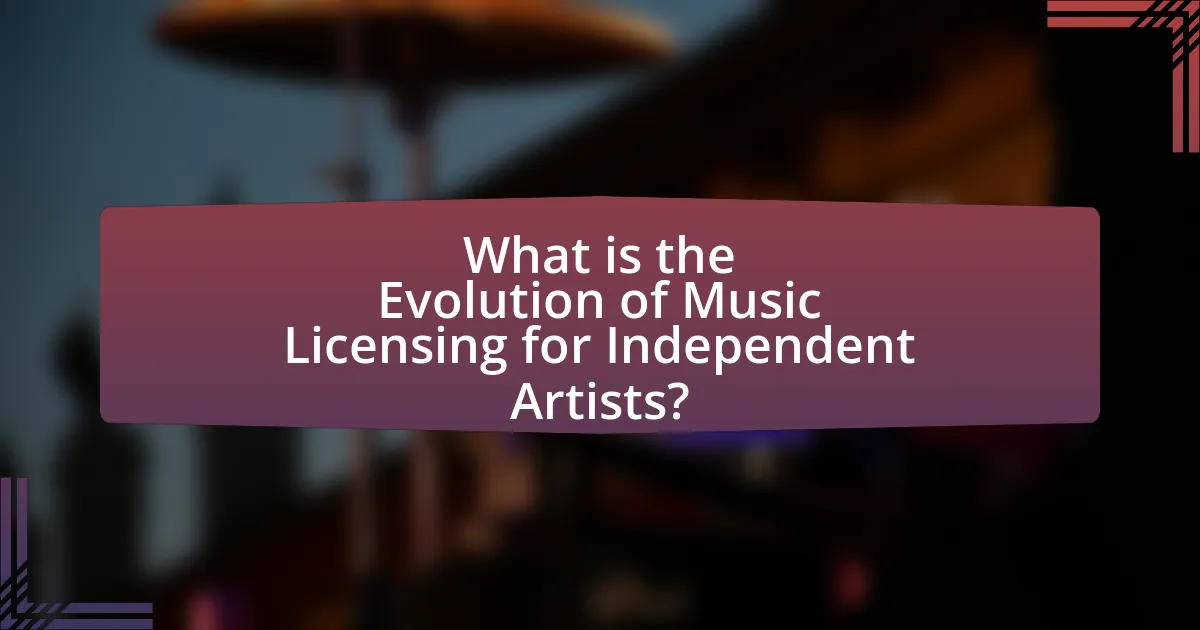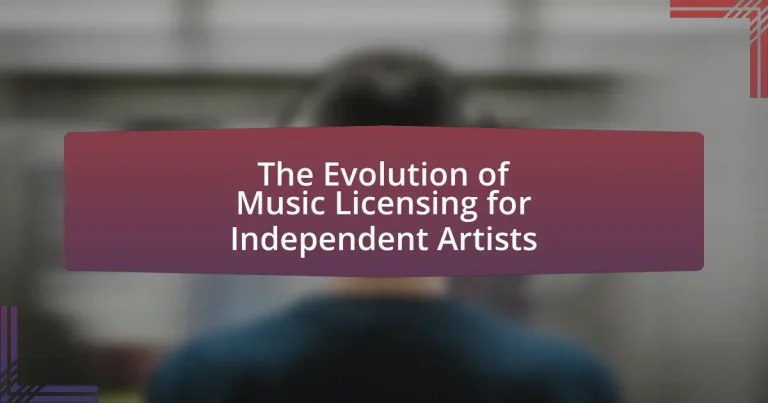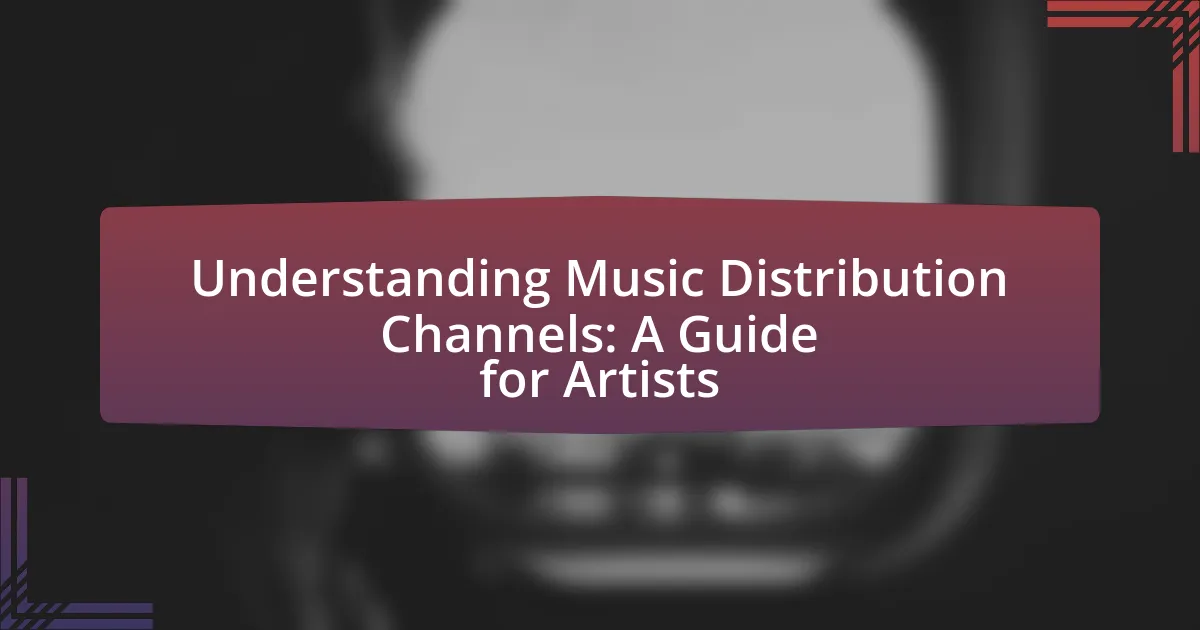The article examines the evolution of music licensing for independent artists, highlighting the transition from restrictive traditional models to more accessible frameworks facilitated by digital platforms. It discusses the impact of technological advancements, such as streaming services and blockchain, on licensing practices, enabling artists to retain control over their rights and monetize their work effectively. Key topics include the importance of licensing for revenue generation, the challenges faced by independent artists, and current trends in sync licensing and music libraries. The article also outlines best practices for navigating licensing agreements and available resources for artists to enhance their understanding of music licensing.

What is the Evolution of Music Licensing for Independent Artists?
The evolution of music licensing for independent artists has transitioned from traditional, restrictive models to more accessible, flexible frameworks. Initially, independent artists faced significant barriers due to the dominance of major record labels, which controlled licensing agreements and distribution channels. However, the rise of digital platforms and streaming services has democratized access to music licensing, allowing independent artists to license their work directly to consumers and media outlets.
For instance, platforms like DistroKid and TuneCore enable artists to distribute their music globally while retaining ownership and control over their rights. Additionally, the introduction of Creative Commons licenses has provided independent artists with options to share their music freely while still protecting their intellectual property. According to a 2021 report by the International Federation of the Phonographic Industry (IFPI), independent labels accounted for 40% of global recorded music revenues, highlighting the growing significance of independent artists in the music industry. This shift illustrates how the landscape of music licensing has evolved to empower independent creators, facilitating greater creative freedom and financial opportunities.
How has music licensing changed over the years for independent artists?
Music licensing for independent artists has evolved significantly, primarily due to advancements in technology and changes in industry practices. In the past, independent artists faced barriers such as limited access to distribution channels and complex licensing agreements that favored major labels. However, the rise of digital platforms and streaming services has democratized music distribution, allowing independent artists to license their music more easily and reach wider audiences.
For instance, services like DistroKid and TuneCore enable artists to distribute their music globally without the need for a traditional record label, simplifying the licensing process. Additionally, the introduction of user-friendly licensing platforms, such as Songtradr and Artlist, has made it easier for independent artists to license their music for various media, including film and advertising.
Statistically, the number of independent artists has surged, with reports indicating that over 40% of music released in recent years comes from independent creators, reflecting a shift in the music licensing landscape that increasingly supports independent talent.
What historical factors influenced the evolution of music licensing?
The evolution of music licensing has been significantly influenced by technological advancements, legal developments, and cultural shifts. The introduction of mechanical rights in the early 20th century, particularly with the advent of the phonograph, necessitated formal licensing agreements to protect artists’ rights and ensure compensation for recorded music. The Copyright Act of 1976 in the United States further solidified these rights by establishing a framework for licensing and royalties, allowing artists to gain legal recognition and financial benefits from their work. Additionally, the rise of digital distribution in the late 20th and early 21st centuries transformed music consumption, leading to new licensing models such as streaming services, which require different agreements to address the complexities of online usage and revenue sharing. These historical factors collectively shaped the current landscape of music licensing, ensuring that artists, including independent ones, have mechanisms to protect their intellectual property and receive fair compensation.
How did technological advancements impact music licensing practices?
Technological advancements significantly transformed music licensing practices by streamlining the process and increasing accessibility for independent artists. The rise of digital distribution platforms and streaming services, such as Spotify and Apple Music, enabled artists to license their music more efficiently and reach a global audience without traditional intermediaries. Additionally, the implementation of blockchain technology has introduced transparent tracking of music usage, ensuring that artists receive fair compensation for their work. According to a 2020 report by the International Federation of the Phonographic Industry, digital music revenues accounted for 56.1% of the global recorded music market, highlighting the shift towards technology-driven licensing models. These advancements have democratized the music industry, allowing independent artists to navigate licensing with greater ease and control over their intellectual property.
Why is music licensing important for independent artists?
Music licensing is crucial for independent artists because it ensures they receive legal protection and financial compensation for their work. By obtaining licenses, artists can control how their music is used in various media, such as films, commercials, and streaming platforms, which can lead to significant revenue streams. For instance, a study by the Music Industry Association found that licensed music generates up to 50% more income for artists compared to unlicensed use. This financial security allows independent artists to invest in their careers and continue creating music.
What are the legal implications of music licensing for artists?
The legal implications of music licensing for artists include the necessity to obtain permission for the use of their work, which protects their intellectual property rights. Artists must navigate various licensing agreements, such as mechanical licenses for reproduction, synchronization licenses for audiovisual use, and performance licenses for public performances. Failure to secure these licenses can result in legal disputes, financial penalties, and loss of revenue. For instance, the U.S. Copyright Act mandates that artists receive royalties for the use of their music, reinforcing the importance of proper licensing to ensure compliance and protect their earnings.
How does music licensing affect an artist’s revenue streams?
Music licensing significantly impacts an artist’s revenue streams by providing legal avenues for monetizing their work through various channels. When artists license their music, they can earn income from multiple sources, including streaming platforms, radio play, television, film, and advertisements. For instance, a study by the Music Industry Research Association found that licensing can account for up to 30% of an artist’s total revenue, highlighting its importance in diversifying income. Additionally, licensing agreements often include performance royalties, which further enhance an artist’s earnings whenever their music is played publicly. This structured approach to monetization through licensing not only increases financial stability for artists but also encourages them to create and distribute more content.
What challenges do independent artists face in music licensing?
Independent artists face significant challenges in music licensing, primarily due to a lack of resources and industry knowledge. Many independent artists struggle to navigate the complex legal landscape of copyright laws, which can lead to unintentional infringement. Additionally, the financial burden of licensing fees can be prohibitive, as independent artists often operate on limited budgets. According to a 2020 survey by the Music Industry Research Association, 70% of independent musicians reported that understanding licensing agreements was a major barrier to their success. Furthermore, the absence of established networks and connections in the industry can hinder their ability to negotiate favorable terms, making it difficult for them to monetize their work effectively.
What are common misconceptions about music licensing for independent artists?
Common misconceptions about music licensing for independent artists include the belief that all music is free to use, that licensing is only necessary for commercial projects, and that the process is overly complicated. Many independent artists assume that they can use any song without permission, but copyright laws protect most music, requiring proper licensing for legal use. Additionally, some artists think that licensing is only relevant when making money from their music, while in reality, even non-commercial use can infringe on copyright. Lastly, the perception that music licensing is too complex often deters artists from seeking the necessary permissions, when in fact, there are straightforward resources and services available to simplify the process.
How do independent artists navigate complex licensing agreements?
Independent artists navigate complex licensing agreements by thoroughly understanding the terms and conditions, often seeking legal advice or using resources like licensing organizations. They educate themselves on copyright laws and the specifics of the agreements to ensure they retain rights to their work while complying with industry standards. For instance, organizations such as the American Society of Composers, Authors and Publishers (ASCAP) provide guidance and resources that help artists comprehend the intricacies of licensing. This proactive approach enables independent artists to make informed decisions, negotiate better terms, and protect their intellectual property effectively.
How can independent artists adapt to the changing landscape of music licensing?
Independent artists can adapt to the changing landscape of music licensing by leveraging digital platforms and understanding new licensing models. Digital platforms like Spotify and YouTube have transformed how music is distributed and monetized, allowing artists to reach wider audiences without traditional gatekeepers. Additionally, artists should familiarize themselves with various licensing options, such as sync licensing for film and television, which has seen a significant increase in demand; for instance, the global music licensing market was valued at approximately $5.5 billion in 2020 and is projected to grow. By actively engaging with these platforms and exploring diverse revenue streams, independent artists can effectively navigate the evolving music licensing environment.
What are the current trends in music licensing for independent artists?
Current trends in music licensing for independent artists include the rise of digital platforms that facilitate direct licensing, increased use of sync licensing for film and television, and the growing importance of music libraries. Independent artists are leveraging platforms like DistroKid and TuneCore to manage their licensing needs efficiently, allowing for greater control over their music rights. Additionally, the demand for original music in media has led to a surge in sync licensing opportunities, with independent artists increasingly being sought after for unique soundtracks. According to a report by the Music Business Association, sync licensing revenue has grown significantly, highlighting its importance for independent creators. Furthermore, music libraries are becoming essential resources, providing independent artists with avenues to license their work easily while reaching broader audiences.
How are digital platforms reshaping music licensing opportunities?
Digital platforms are reshaping music licensing opportunities by providing independent artists with direct access to a global audience and streamlined licensing processes. These platforms, such as Spotify, Apple Music, and YouTube, enable artists to distribute their music widely without traditional intermediaries, thus increasing their visibility and potential revenue streams. For instance, the rise of services like DistroKid and TuneCore allows artists to license their music for streaming and synchronization in films or commercials easily, often with lower fees and faster turnaround times compared to traditional methods. Additionally, data analytics from these platforms help artists understand their audience better, allowing for more targeted licensing strategies. This shift has led to a democratization of music licensing, empowering independent artists to monetize their work more effectively.
What role do music libraries and sync licensing play for independent artists?
Music libraries and sync licensing provide independent artists with essential avenues for monetizing their work and gaining exposure. By placing their music in libraries, artists can have their tracks licensed for use in films, commercials, and television shows, which can lead to significant revenue streams. According to a report by the Music Business Association, sync licensing has become a crucial income source for many independent musicians, with the global sync licensing market projected to reach $1.5 billion by 2025. This financial incentive, combined with the increased visibility that comes from being featured in popular media, underscores the vital role that music libraries and sync licensing play in the careers of independent artists.
What best practices should independent artists follow for effective music licensing?
Independent artists should prioritize clear documentation and understanding of licensing agreements to ensure effective music licensing. This involves creating detailed contracts that specify usage rights, payment terms, and duration of the license. Additionally, artists should register their works with performance rights organizations, which can help track usage and collect royalties. According to the American Society of Composers, Authors, and Publishers (ASCAP), proper registration can significantly increase an artist’s revenue potential by ensuring they receive compensation for public performances. Furthermore, independent artists should actively network with music supervisors and industry professionals to stay informed about licensing opportunities and trends, enhancing their chances of successful placements.
How can independent artists ensure they are properly licensed?
Independent artists can ensure they are properly licensed by registering their works with a performing rights organization (PRO) such as ASCAP, BMI, or SESAC. These organizations help artists manage their copyrights and collect royalties on their behalf, ensuring that they receive compensation when their music is played publicly. Additionally, artists should consider obtaining mechanical licenses for physical copies of their music and sync licenses for use in film or television. According to the U.S. Copyright Office, registering a copyright provides legal protection and the ability to enforce rights in court, which further solidifies an artist’s licensing status.
What resources are available for independent artists to learn about music licensing?
Independent artists can access various resources to learn about music licensing, including online courses, industry websites, and books. Websites like the American Society of Composers, Authors and Publishers (ASCAP) and the Broadcast Music, Inc. (BMI) provide comprehensive guides and articles on licensing. Additionally, platforms such as Coursera and Udemy offer courses specifically focused on music licensing, covering essential topics like copyright law and licensing agreements. Books like “Music Licensing: A Practical Guide” by Michael A. B. and “The Complete Guide to Music Licensing” by David H. also serve as valuable resources for understanding the complexities of music licensing. These resources collectively equip independent artists with the knowledge needed to navigate the licensing landscape effectively.





